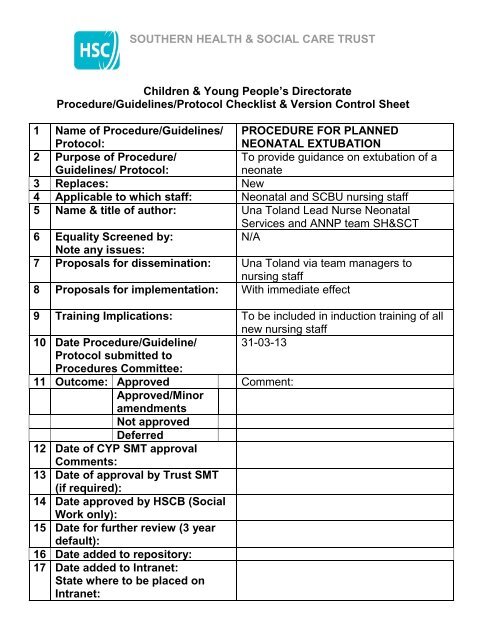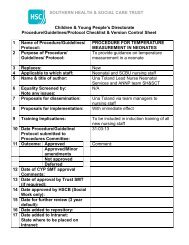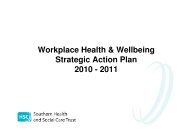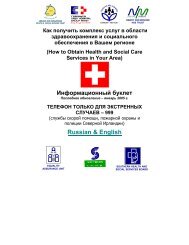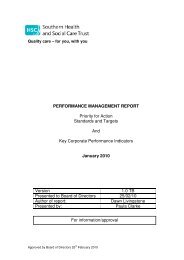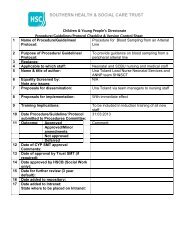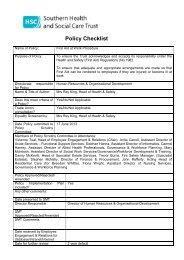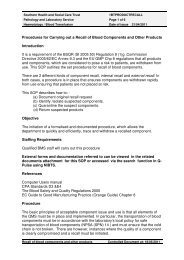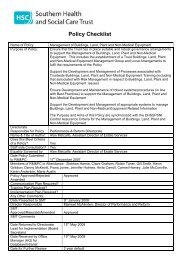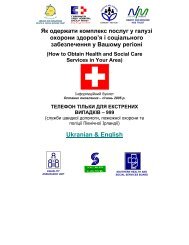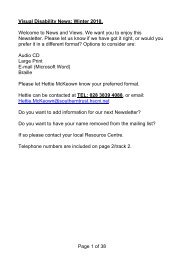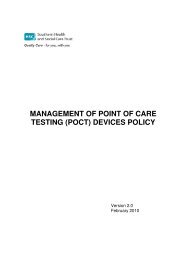Planned Neonatal Extubation - Southern Health and Social Care Trust
Planned Neonatal Extubation - Southern Health and Social Care Trust
Planned Neonatal Extubation - Southern Health and Social Care Trust
You also want an ePaper? Increase the reach of your titles
YUMPU automatically turns print PDFs into web optimized ePapers that Google loves.
SOUTHERN HEALTH & SOCIAL CARE TRUSTChildren & Young People’s DirectorateProcedure/Guidelines/Protocol Checklist & Version Control Sheet1 Name of Procedure/Guidelines/Protocol:PROCEDURE FOR PLANNEDNEONATAL EXTUBATION2 Purpose of Procedure/Guidelines/ Protocol:To provide guidance on extubation of aneonate3 Replaces: New4 Applicable to which staff: <strong>Neonatal</strong> <strong>and</strong> SCBU nursing staff5 Name & title of author: Una Tol<strong>and</strong> Lead Nurse <strong>Neonatal</strong>Services <strong>and</strong> ANNP team SH&SCT6 Equality Screened by:N/ANote any issues:7 Proposals for dissemination: Una Tol<strong>and</strong> via team managers tonursing staff8 Proposals for implementation: With immediate effect9 Training Implications: To be included in induction training of allnew nursing staff10 Date Procedure/Guideline/ 31-03-13Protocol submitted toProcedures Committee:11 Outcome: Approved Comment:Approved/MinoramendmentsNot approvedDeferred12 Date of CYP SMT approvalComments:13 Date of approval by <strong>Trust</strong> SMT(if required):14 Date approved by HSCB (<strong>Social</strong>Work only):15 Date for further review (3 yeardefault):16 Date added to repository:17 Date added to Intranet:State where to be placed onIntranet:
SOUTHERN HEALTH & SOCIAL CARE TRUSTPROCEDURE FOR PLANNED NEONATAL EXTUBATIONStatement:When an infant has shown improvement in clinical condition with stable bloodgases, extubation should be considered.Prior to extubation always inform medical staff/ANNP of pending procedure asthere is always a risk that the infant may deteriorate once the endotracheal tubehas been removed. It is important that resuscitation <strong>and</strong> reintubation equipmentis available in the event of an emergency. Most preterm infants will be extubatedto CPAP to prevent atelectasis.<strong>Extubation</strong> is a 2 man procedure.Equipment:Disposable apronNon-sterile glovesNeopuff with appropriate size face mask <strong>and</strong> free flowing air/oxygen mixSuction catheter <strong>and</strong> suctioning apparatusStethoscopeCPAP equipment (see procedure for initiating CPAP in a neonate)ACTIONWhere possible inform parents of plannedprocedure.RATIONALETo gain informed consent <strong>and</strong> cooperation.Check resuscitation equipment is working.Ensure CPAP or incubator oxygen set up<strong>and</strong> ready for use.Place infant in supine position –headmidline.Ensure vital signs stable beforeproceeding.If infant on continuous milk feeds turn offmilk feeds prior to the procedure <strong>and</strong>consider aspirating contents of thestomach.To ensure resuscitation equipment readyfor use in the event of deterioration ininfants condition.To ensure adequate respiratory support<strong>and</strong> oxygen for infant post extubation.Appropriate positioning of infants allowsmaximum ventilation. Turning of the headcan impede the blood flow to the jugularvein.Reduces risk of aspiration.
SOUTHERN HEALTH & SOCIAL CARE TRUSTDecontaminate h<strong>and</strong>s as per local policyadhering to 7 step technique <strong>and</strong> 5moments of h<strong>and</strong> hygiene.Using Olive oil remove tape securing ETTin place carefully. Consider giving a fewdrops of sucrose for pain relief unlesscontraindicatedApply suction to the mouth if required <strong>and</strong>change suction catheter.Insert clean suction catheter down ETT topredetermined length, apply suction <strong>and</strong>withdraw the catheter noting colour,amount <strong>and</strong> consistency of secretionsRepeat suctioning until secretions areminimal.Insert clean suction catheter down ETT<strong>and</strong> withdraw the catheter simultaneouslywith the ETT.Apply facial mask oxygen if required <strong>and</strong>initiate CPAP promptly if indicated.To reduce risk of cross contamination.Avoids skin damage <strong>and</strong> facilitates ease ofremoval of ETT.To ensure clear airway.Reduces risk of aspiration if infant inhalesmucous whilst ETT is removed.Ensures continual respiratory support <strong>and</strong>oxygenation to infant.If additional oxygen only requiredcommence incubator oxygen.It may be beneficial for the infant to benursed prone following extubation.Positioning will depend on infants’condition.<strong>Extubation</strong> may provide the firstopportunity to obtain a photograph of theinfants face for the parents. If the infants’condition allows, obtain a photographbefore applying CPAP.Observe the infants response to extubation<strong>and</strong> continue to monitor for any signs ofrespiratory distress.Measure <strong>and</strong> record a blood gas one hourpost extubation or as ordered.Record all details of the procedure in theinfants chart.The prone position improves oxygenationdue to mechanical advantages on chestwall expansion.To provide on-going support to parents<strong>and</strong> to promote attachment <strong>and</strong> bonding.To allow detection of increasing distresspost extubation <strong>and</strong> allow prompt responseto alleviate same.To monitor respiratory status.To ensure adherence to NMC st<strong>and</strong>ardsfor record keeping.March 2013
SOUTHERN HEALTH & SOCIAL CARE TRUSTReferences:Aziz et al. the paediatric disposable end tidal CO2 detector role in endotrachealintubation in new-borns. J. Perinatal. 1999; 19:119-113Barrington KJ, Byrne PJ. Premedication for neonatal intubation. Am J Perinatol.1998 April 15(4):213-216Bhutada A, Sahni R, Rastogi S Wung J-T. R<strong>and</strong>omised control trial of thiopentalfor intubation in neonates. Arch dis Child Fetal neonatal Ed 2000; 82; F34Boxwell G. <strong>Neonatal</strong> Intensive <strong>Care</strong> Nursing (2000) pp289-292Hinkle AJ Awake neonatal laryngoscopy: pre oxygenation alone versuscontinuous oxygenation. Anaesthesiology. 1983 Sep; 59(3): A437Up to date. <strong>Neonatal</strong> resuscitation. Accessed fromwww.uptodate.com/online/content/topic.do?topicKey=neonatol/28891&view=p...31/08/10Wylie JP. <strong>Neonatal</strong> tracheal Intubation. Arch Dis Child Pract. 2008; 93:44-49


